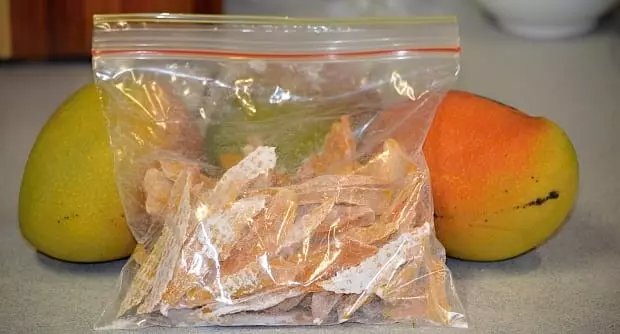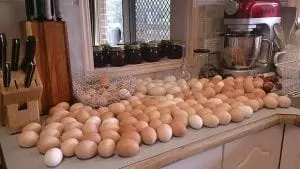Preserving mangoes through dehydration (drying) is one the best and easiest ways to store them because dried mango tastes nice, is a very healthy snack, it’s not messy to eat, and it lasts a long time in the pantry.
To buy this organic gourmet snack from a health food store or supermarket usually costs over $60 per kilogram! Therefore, making your own dehydrated mango definitely saves money whether you buy the mangoes fresh (at the right price) or grow them yourself.

We have about 10 mango trees on our small property so we usually produce more mangoes than we can eat fresh or give away and whilst mangoes can be preserved in many different ways my preferred method is dehydration because:
- There’s no cooking required and that means more nutrients remain in the fruit and it’s less fuss to do;
- Dried mango pieces are convenient to use for snacks (like kids lunches, parties, hiking, camping), or in cooking, desserts, and a myriad of other ways;
- It doesn’t need to be refrigerated and can be stored in a cupboard/pantry saving valuable fridge and freezer space; and
- Dehydrated mango pieces taste awesome! It’s like eating a concentrated mango lolly but with all the goodness of pure fruit.
The other often overlooked point about preserving your own mangoes (or any fruit) is it's a good way to "save" those mangoes which are not in the best condition. That is, any mangoes which are bruised, going to spoil fast due to disease/insect bite, or ripening too fast, can be cut up with the bad discarded and the good bits preserved to eat at our leisure. Then, there's no need to get "sick" gorging ourselves full of mango just because they needed to be eaten before they went rotten. 
To effectively dehydrate mangoes you’ll need a food dehydrator so if you don’t have one and are looking, I recommend the larger square/rectangle types. Whether you decide to buy the expensive branded dehydrators or the much cheaper Chinese versions it’s up to you, but I would personally not get the rounded stacked dehydrators – I purchased my dehydrator from eBay here.
How to dehydrate mangoes
Firstly, the main equipment & ingredients required are:
- Food dehydrator;
- Bowl with about 1 litre of water;
- Mangoes (quantity of);
- Citric acid 1 x teaspoon (or about ½ cup freshly squeezed lemon juice);
- Icing sugar (just a small amount).
Method
Step 1 – Peel and cut up Mangoes
Remove the skin of the mangoes and then cut them into slices about 1 cm thick x 4 cm wide. It doesn’t really matter too much about sizes or widths just do your best to cut the mango from the seed and try keeping the thickness to about 1 cm where possible.
Step 2 – Citric acid dip
Mix the teaspoon of citric acid (or ½ cup lemon juice) with a litre of water into a bowl. Place the sliced mango into the water as you cut it up.
Citric acid is a natural derivative of citrus (usually lemons) in a powdered form and is used to stop the mango from oxidising and going brown so it will retain its vibrant orange colour when dried.
If you’d rather not use citric acid or lemon juice the end product will look a little brownish but still taste fine.

Step 3 – Dehydrating
Place the sliced mango onto the dehydrator tray/s evenly spaced apart and then straight into the food dehydrator set on 55 °C (131 °F) for about 18 hours or until the mango pieces are dried and not sticky to touch but still pliable. The mango pieces should not be over dried and crunchy as it is best left a little softer; however, if you do over-dry the mango it will still taste good albeit a little hard to chew.

Step 4 – Dusting and storing (this is optional and certainly not necessary)
Dust dried mango with icing sugar by adding 1 x teaspoon of icing sugar to a sandwich bag full of dried mango and shake until all pieces are dusted. You only need a small amount of icing sugar to coat the mango pieces.
The icing sugar helps prevent the dehydrated mango from collecting moisture (keeps it dry) plus it also counteracts the tartness of the citric acid or lemon juice.
Store the mango pieces in sealed containers or simply in plastic zip-lock bags and place them into the cupboard or pantry. Dried mango pieces should last at least 6 months.

Useful links
Food dehydrators – eBay (Aust)
Conclusion
We often think of exotic tropical fruits like mangoes as something best eaten in its true form: in season, plump, sweet, and juicy. That’s very true, however, it’s also true mangoes can’t be produced all year round locally so it makes sense to look at ways to enjoy this wonderful fruit out of season and there’s no better way than through dehydration.
Next time you go down the preserved fruit aisle at the supermarket, take note of the price for a small bag of dried mango – it’s ridiculous for something that is just so easy to make at home!
Talk about this below or in our forum under the Preserving section.
Mark Valencia – Editor SSM
Look, and see the Earth through her eyes…












